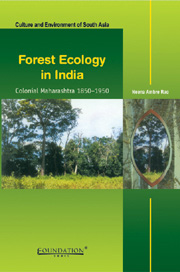Book contents
- Frontmatter
- Contents
- Preface
- Glossary
- Maps
- 1 Introduction
- 2 Pre-Colonial Maharashtra
- 3 Early British Management of Forests
- 4 Evolution of Forest Policy and Forest Acts of 1865 and 1878
- 5 Implementation of 1878 Act
- 6 Forest Policy During 1900–1950
- 7 People's Resistance
- 8 Conclusion
- Appendix - I
- Appendix - II
- Bibliography
- Index
Appendix - I
Published online by Cambridge University Press: 26 October 2011
- Frontmatter
- Contents
- Preface
- Glossary
- Maps
- 1 Introduction
- 2 Pre-Colonial Maharashtra
- 3 Early British Management of Forests
- 4 Evolution of Forest Policy and Forest Acts of 1865 and 1878
- 5 Implementation of 1878 Act
- 6 Forest Policy During 1900–1950
- 7 People's Resistance
- 8 Conclusion
- Appendix - I
- Appendix - II
- Bibliography
- Index
Summary
Sacred Plants of Bombay Presidency
Botany Gazeteer of Bombay Presidency Volume XXV Government Central Press, 1886.
Sacred Plants
Plants mentioned in the religious books and used in religious ceremonies of the Hindus.
The Hindus hold the belief that the Gods inhabit or frequent all sweet-scented or flowering plants; as such are never haunted by evil spirits. Therefore, a good member of plants are worshipped or used in some of their religious ceremonies. The most important are the following:
i. Butea Frondosa (Palas)
ii. Prosopis Spicigera (Shami)
iii. Bauhinia Racemosa (Apta)
iv. Calotropis Gigantea (Rui)
v. Achyranthes Aspera (Agarah)
vi. F. Glomerata (Umbar)
vii. Ficus Bengalensis (Vad)
viii. F. Religiosa (Pipal)
ix. Cynodon Dactylon (Dub)
x. Eragrostis Cynosuroides (Kush)
xi. Eugenia Jambolana (Jambul)
xii. Mangifera Indica (Amb)
xiii. F. Cordifolia (Pair)
xiv. Ocymum Sanctum (Tulus)
xv. Phyllanthus Emblica (Aula)
xvi. Musa Paradisiaca (Kela)
xvii. Aegle Marmelos (Bel)
xviii. Saraca Indica (Jassundi Ashok)
xix. Rbita Pepo (Kohala)
xx. Mus Sativus (Kakdi)
xxi. Anus Odoratissimus (Keuda)
xxii. Azadirachta (Nim)
Butea frondosa(Palas)
The leaves of this plant are trifoliate: the middle leaflet is supposed to represent Vishnu, the left Brahma and the right Shiv. Hence, its worship is enjoined in Chaturmas Mahatma. It is used in the following three great ceremonies:
The leaves are used as platters on the occasion of the investiture of the sacred thread, when a particular part of the ceremony, called chewul (that is when the barber removes the last tuft of hair from the head of the child to be invested), is being performed.
- Type
- Chapter
- Information
- Forest Ecology in IndiaColonial Maharashtra, 1850-1950, pp. 224 - 235Publisher: Foundation BooksPrint publication year: 2007



